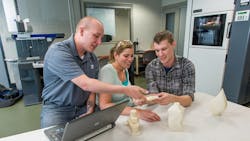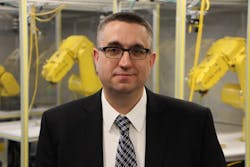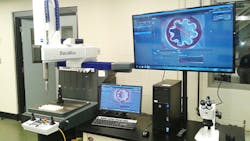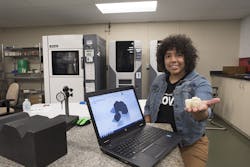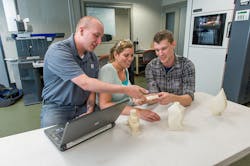E.J. Daigle is Dean of Robotics & Manufacturing at Dunwoody College of Technology in Minneapolis. The Robotics & Manufacturing Department includes two- and four-year degrees in Automation, Design, Electronics, Engineering, Machining, Robotics and Welding. “At Dunwoody, we place a focus on hands-on applied learning that resembles the industry,” says Daigle, who recently had a conversation with Machine Design. Here are some excerpts:
What’s your background?
My background includes a B.S. in Applied Mathematics and a M.S. in Manufacturing Engineering. Prior to Dunwoody, I served in the U.S. Navy for 10 years during which time I was fortunate enough to work in the General Dynamics Shipyard in Groton, Conn., as part of the pre-commissioning crew of the nuclear submarine USS Rhode Island. I went on to serve aboard two nuclear submarines during my naval service.
What does the future of engineering education look like from your perspective?
It's going to be important, if not critical, for engineering education to help and encourage students go beyond the textbook and syllabus material of their courses of education. Students will benefit greatly from a polytechnic approach to learning that allows them to apply engineering principles in a wide variety of ways. This approach is already particularly relevant in the manufacturing world. The onset of CAD, CAM, CNC, and 3D printing has resulted in a world where parts can rapidly migrate from engineering design to finished product in hours or minutes. The ability for an engineer to design for real world manufacturability, constructability or serviceability will become even more important in the coming decades as this technology becomes more prevalent and integrated into every facet of industry.
It is important to make equipment easy to access and similar to the industrial grade equipment they will see in industry. This reduces the gap between student and professional.
At Dunwoody, we focus on an equal balance between academic rigor and ensuring students have day to day experience with the tools, techniques and materials they will encounter in their chosen workplaces. As the pace of technical innovation will only quicken in the future, it will be even more important for educational institutions to foster much closer working partnerships with employers to enable students to gain real-time experience of the tools, materials, software and processes needed on the job.
What are some of those new approaches, tools, and techniques in preparing engineering undergraduates for the workplace of today?
New materials and technologies are taking the market by storm. In less than 20 years, 3D printing has completely disrupted the industry to the point where 71% of manufacturers are currently using 3D printing in some capacity.
Understanding software to build tangible designs give students confidence, and important hands-on experience that books just can’t offer. 3D printing allowed Jazmine to take her design (concept) to reality in only a few short hours.
Another example is the boom in demand for, and understanding of, sustainable and biodegradable materials and what they can do. This also represents an exciting opportunity to reduce our production footprint on the environment while maintaining high standards of strength and reliability in finished products.
How are advances in technology, materials, and access to workplace training environments shaping the ways in which new engineers are trained and more fully prepared for their careers?
Computer software packages in CAD, CAM, and simulation allow engineers and technicians to model the design and build tooling, parts, and assemblies prior to ever ordering materials for a given project or job. Engineering education needs to adapt to these new technologies by preparing engineers to be productive from day one.
What is the outlook for newly graduated engineers today?
Speaking from the Twin Cities metro area, there are more than 100 companies within a 20-mile radius of Dunwoody College that manufacture medical devices. This region of the country is known as “Medical Alley” because of its leadership role in medical device manufacturing. Some of these companies such as Medtronic, Boston Scientific, and St. Jude are household names, while most people do probably not know the vast majority like Custom Mold, RMS, Dynamic Group, Donatelle, and Mendell. These employers have been screaming for engineers that understand advanced manufacturing processes that include multi-axis CNC machining, Swiss turning, and injection molding, to name just a few processes.
Our placement rate for graduates in their chosen career path is in the 98th percentile across the board and many of our students are accepting positions long before they graduate. We hear from similar education institutions across the country that demand for skilled workplace engineers has, perhaps, never been higher. In short, if you’re a graduate of an engineering program today, and you bring with you to your potential employer a sound academic foundation, real world tools and technology experience, and a willingness to embrace rapid innovation and change, you’re going to do well.
Deloitte (2016) finds that 2 million jobs will go unfilled over the next decade due to a shortage of skilled workers in manufacturing. Manufacturing still represents one of the largest sectors contained in the U.S. GDP. Unlike the 1970s and 80s when companies offshored manufacturing to save on labor costs, the 21st century has shown a push to offshore to find skilled labor. Modern U.S. manufacturing facilities rarely (if ever) require human labor to touch the part instead opting for industrial automation.
Understanding 3D printing for prototyping will help students excel in the field. In addition, it is important to educate them on new technologies so they know how processes can be improved when they get into the industry.
What are you seeing as disruptive (positive, negative, or both) influences in your industry and markets?
Rapid manufacturing processes like those used at ProtoLabs (Maple Plain, Minn.) allow even novice users the opportunity to go from concept to finished part in less than 24 hours. As the cost of 3D printers and CNC machines comes down, access to these machines will become even more prevalent. We already see this in the case of making a spare key for your house. In the 1980s you would bring your key to the hardware store, find a worker, and they would cut a new key on a benchtop key cutter. Today this has been replaced by a vending machine where you swipe your credit card, insert your key, and watch the vending machine cut the key automatically. The next step would be a vending machine that could duplicate almost anything. Imagine a store you walk into that has several 3D production systems (no dedicated inventory). No matter what the material is, you could walk in, scan your sample or search for your part in a database and build the part. A wrench, a comb, a key, a bowl, salt shaker, etc., any of these items could be produced in a matter of minutes from your choice of materials; polymers, metals, ceramics, etc.
